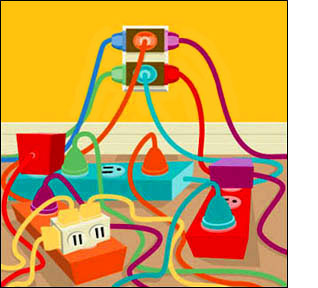 Suppose that you are using a 150-watt light bulb in a bathroom that has an electrical outlet on the same circuit. It is winter time and you are heating the room with a 3600-watt space heater plugged into the outlet. You plug your 1800-watt hair dryer into the outlet and begin to dry your hair and all of a sudden everything turns off. You are left in the dark with a wet head and cold feet. This is an example of what is called overload. An overload is when the amperage put over a wire or circuit is more than it can handle.
Suppose that you are using a 150-watt light bulb in a bathroom that has an electrical outlet on the same circuit. It is winter time and you are heating the room with a 3600-watt space heater plugged into the outlet. You plug your 1800-watt hair dryer into the outlet and begin to dry your hair and all of a sudden everything turns off. You are left in the dark with a wet head and cold feet. This is an example of what is called overload. An overload is when the amperage put over a wire or circuit is more than it can handle.
Let’s figure out what happened to better understand overload. Remember that there is a relationship between amperes, volts, and watts that can help us. The rule tells us that amperes equals watts divided by volts.
I = W ÷ V
We know that the circuit in your home is a 120-volt circuit, which is standard in homes in the U.S. We also know the wattage of each appliance. Now let’s determine how much current (amperes) is being drawn by each appliance.
